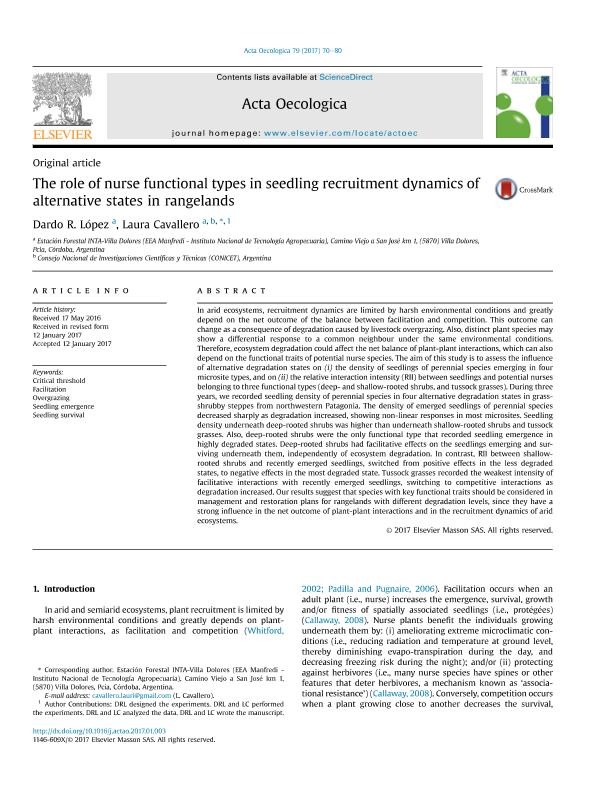Mostrar el registro sencillo del ítem
dc.contributor.author
López, Dardo R.
dc.contributor.author
Cavallero, Laura

dc.date.available
2020-02-18T18:44:34Z
dc.date.issued
2017-02
dc.identifier.citation
López, Dardo R.; Cavallero, Laura; The role of nurse functional types in seedling recruitment dynamics of alternative states in rangelands; Gauthier-Villars/Editions Elsevier; Acta Oecologica; 79; 2-2017; 70-80
dc.identifier.issn
1146-609X
dc.identifier.uri
http://hdl.handle.net/11336/97934
dc.description.abstract
In arid ecosystems, recruitment dynamics are limited by harsh environmental conditions and greatly depend on the net outcome of the balance between facilitation and competition. This outcome can change as a consequence of degradation caused by livestock overgrazing. Also, distinct plant species may show a differential response to a common neighbour under the same environmental conditions. Therefore, ecosystem degradation could affect the net balance of plant-plant interactions, which can also depend on the functional traits of potential nurse species. The aim of this study is to assess the influence of alternative degradation states on (i) the density of seedlings of perennial species emerging in four microsite types, and on (ii) the relative interaction intensity (RII) between seedlings and potential nurses belonging to three functional types (deep- and shallow-rooted shrubs, and tussock grasses). During three years, we recorded seedling density of perennial species in four alternative degradation states in grass-shrubby steppes from northwestern Patagonia. The density of emerged seedlings of perennial species decreased sharply as degradation increased, showing non-linear responses in most microsites. Seedling density underneath deep-rooted shrubs was higher than underneath shallow-rooted shrubs and tussock grasses. Also, deep-rooted shrubs were the only functional type that recorded seedling emergence in highly degraded states. Deep-rooted shrubs had facilitative effects on the seedlings emerging and surviving underneath them, independently of ecosystem degradation. In contrast, RII between shallow-rooted shrubs and recently emerged seedlings, switched from positive effects in the less degraded states, to negative effects in the most degraded state. Tussock grasses recorded the weakest intensity of facilitative interactions with recently emerged seedlings, switching to competitive interactions as degradation increased. Our results suggest that species with key functional traits should be considered in management and restoration plans for rangelands with different degradation levels, since they have a strong influence in the net outcome of plant-plant interactions and in the recruitment dynamics of arid ecosystems.
dc.format
application/pdf
dc.language.iso
eng
dc.publisher
Gauthier-Villars/Editions Elsevier

dc.rights
info:eu-repo/semantics/openAccess
dc.rights.uri
https://creativecommons.org/licenses/by-nc-sa/2.5/ar/
dc.subject
CRITICAL THRESHOLD
dc.subject
FACILITATION
dc.subject
OVERGRAZING
dc.subject
SEEDLING EMERGENCE
dc.subject
SEEDLING SURVIVAL
dc.subject.classification
Conservación de la Biodiversidad

dc.subject.classification
Ciencias Biológicas

dc.subject.classification
CIENCIAS NATURALES Y EXACTAS

dc.title
The role of nurse functional types in seedling recruitment dynamics of alternative states in rangelands
dc.type
info:eu-repo/semantics/article
dc.type
info:ar-repo/semantics/artículo
dc.type
info:eu-repo/semantics/publishedVersion
dc.date.updated
2020-02-12T17:49:06Z
dc.journal.volume
79
dc.journal.pagination
70-80
dc.journal.pais
Francia

dc.journal.ciudad
Paris
dc.description.fil
Fil: López, Dardo R.. Instituto Nacional de Tecnología Agropecuaria. Centro Regional Córdoba. Estación Experimental Agropecuaria Manfredi. Estación Forestal Villa Dolores; Argentina
dc.description.fil
Fil: Cavallero, Laura. Instituto Nacional de Tecnología Agropecuaria. Centro Regional Córdoba. Estación Experimental Agropecuaria Manfredi. Estación Forestal Villa Dolores; Argentina. Consejo Nacional de Investigaciones Científicas y Técnicas; Argentina
dc.journal.title
Acta Oecologica

dc.relation.alternativeid
info:eu-repo/semantics/altIdentifier/url/https://www.sciencedirect.com/science/article/pii/S1146609X17300176?via%3Dihub
dc.relation.alternativeid
info:eu-repo/semantics/altIdentifier/doi/http://dx.doi.org/10.1016/j.actao.2017.01.003
Archivos asociados
